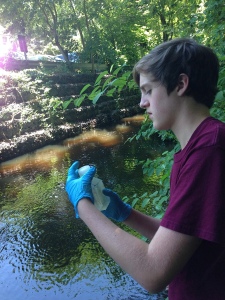Monitoring finds dangerous levels of bacteria at Beaver Swamp Brook and Hutchinson River, cleaner beaches
FOR IMMEDIATE RELEASE
Monday, October 20, 2014
CONTACT
Laura McMillan: 203-787-0646 x137
Sarah Ganong: 203-787-0646 x128
Mamaroneck, NY – Save the Sound’s summer water quality testing program has revealed elevated levels of bacteria at locations in and around Mamaroneck Harbor, confirming the presence of fecal contamination that makes some area beaches and waterways unsafe for swimming each summer.
“The tens of millions of people who live around the Sound, and every visitor to our shores, deserve beaches that are safe for swimming,” said Tracy Brown, director of Save the Sound’s Western Long Island Sound program. “But many sewer systems around the Sound are old, and in Westchester and elsewhere deteriorated pipes allow raw sewage to mix with rainwater. That contaminated mixture flows out into the rivers and streams that run through our backyards, and onto the beaches where our children play. With the help of a dedicated crew of volunteers and the cooperation of local officials, we’re identifying the worst of the pollution and working to eliminate it.”
This was the second year of monitoring bacteria levels in Westchester County for Save the Sound, which is a bi-state program of Connecticut Fund for the Environment. This year Save the Sound focused on the Mamaroneck Harbor Watershed (including Mamaroneck River, Sheldrake River, Beaver Swamp Brook, Otter Creek, and Mamaroneck Harbor itself), the Hutchinson River, and five Westchester beaches that are automatically closed in wet weather due to a history of fecal contamination. Staff and trained volunteers took over 200 samples at 35 testing sites.
Save the Sound tests for Enterococcus and fecal coliform bacteria, two EPA-approved indicators of fecal matter, and has the samples analyzed at labs in Valhalla, NY and Westport, CT. The waste stream can also contain excess nitrogen, which contributes to the Sound’s low-oxygen dead-zone, as well as pharmaceuticals, cleaning products, oils, and other toxins that are harmful to wildlife and the aquatic ecosystem.
Rivers and streams were the most likely to exceed bacteria guidelines, with one Beaver Swamp Brook site near Rye Neck High School in Mamaroneck showing particularly high dry-weather levels that may indicate a 24/7 sewage leak. Thanks to an anonymous citizen report, we learned of a sewage outflow into the Hutchinson River where we discovered the water had fecal coliform levels 40 times the acceptable threshold. We are pushing the City of Mount Vernon to rectify the problem quickly and keep the public informed.
Beaches fared better overall. The cleanest beach we tested is Coveleigh Club in Rye, which had acceptable water quality in dry and wet weather. The beaches with the highest contamination results, Harbor Island and Shore Acres, are located in Mamaroneck Harbor. Our data documents unacceptably high fecal contamination in the Mamaroneck and Sheldrake rivers, and Beaver Swamp Brook and Guion Creek, all of which flow into Mamaroneck Harbor and deliver polluted water to these beaches. Fecal contamination levels increase when it rains.
“The data we’ve collected over the last two summers, and which we’ll continue to monitor going forward, are invaluable in identifying pollution sources so they can be cleaned up. We’re sharing the results with the county health department and local officials,” Brown said. “We urge residents to keep an eye out for sewage overflows and report them, to reduce their personal water usage, maintain their sewers, and call on local officials to maintain and repair community sewers. Together we can reach our goal of safe beaches and vibrant life in the Sound’s waters.” Pollution reports can be emailed to Save the Sound at pollution@savethesound.org.
The data sets, maps, and further analysis can be viewed on Save the Sound’s website:
Water Quality Monitoring Program background
###
Save the Sound is a bi-state program of Connecticut Fund for the Environment with an established 40-year track record of restoring and protecting the waters and shorelines of the Sound. From its offices in New Haven and Mamaroneck, Save the Sound works for a cleaner, healthier, and more vibrant Long Island Sound where humans and marine life can prosper year-round. Our success is based on scientific knowledge, legal expertise, and thousands of ordinary people teaming up achieve results that benefit our environment for current and future generations.
